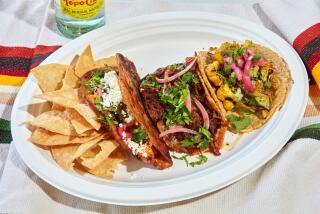Psst, want Chiu Chow?
We had to get to Seafood Village ahead of the crowds, my Hong Kong-born neighbor insisted. But even before 6 p.m. when we reached Monterey Park, people were already milling outside the restaurant waiting for a table.
My neighbor, after her recent trip home, wasn’t surprised. The restaurant’s specialty, Chiu Chow cuisine, has reached trend status in Hong Kong. But it’s infrequently found in Southern California, so there’s a pent-up craving among Hong Kong expats for this delicate, delicious food. Not only is the original Seafood Village in Monterey Park perpetually mobbed, but the two new branches in Temple City and Rowland Heights are equally busy.
It’s easy to understand the allure. Chiu Chow (Chaozhou) cooking is filled with exquisitely light yet assertively flavored dishes and is punctuated with the occasional peppery punch. These are qualities esteemed in modern China -- and for that matter, by cosmopolitan diners around the world.
The dual nature of the food evolved during the Chiu Chow diaspora. Originally the cuisine was based on seafood from freshwater deltas and the ocean along the coast of Guangdong (Canton), the province that borders Hong Kong. Oil, a scarce commodity, was sparingly employed. Instead, deeply flavorful broths became the cooking medium of choice and remain the soul of the cuisine today. When poverty and political turmoil drove many Chiu Chow as refugees to Hong Kong, Thailand and Vietnam, local ingredients influenced the food, and spicy dishes worked their way into the repertoire.
Modern restaurant chefs have refined the cooking, but it is still centered on poaching and steaming. Tangy citrus notes and sharp vinegar condiments brighten fish and greens such as watercress and water spinach. Hong Kong considers it a light cuisine. Maybe that’s why, when we finally got a table, we didn’t see the famous Chiu Chow-style goose on the menu. “Too heavy,” my friend surmised, although we found plenty of authenticity and richness in such dishes as salty lemon duck soup and frittata-like baby oysters with scrambled eggs.
The dining room of Seafood Village hums with energy. Although some Cantonese dishes are served, the emphasis is clearly on Chiu Chow. At almost every table, you see diners demolishing immense platters of cold crab Chiu Chow style, a specialty of the house, which, according to cookbook author Ken Hom, is steamed upside down so the juices and flavors are retained in the shell. The Seafood Village version has been cracked at the joints so the meat is easier to lift. Spicy pickled cabbage and a red vinegar dipping sauce serve as a tart counterpoint. But the crab, recently pulled from the restaurant’s tanks, is so briny and fresh it really needs no condiment.
The dishes that demonstrate the kitchen’s mettle are those based on poaching and braising. The restaurant’s fish broth, so rich that it turns into an aspic when it cools, flavors bass poached at the table in a bubbling chafing dish and the classic Chiu Chow porridge, a rice soup loaded with tiny oysters, baby clams, slivers of smoky dry fish and shrimp.
The exotic “four delicacy” vegetables is a layered creation of nappa cabbage, mushrooms and greens, all braised until meltingly tender. Shrimp buns -- little hobo’s bundles of diced shrimp wrapped in a thin sheet of eggy dough and tied with a chive “ribbon” -- are steamed and served in a shallow, saucy puddle of viscous seafood broth.
On another visit, we tried the salty lemon fish, which turned out to be an unfamiliar whole freshwater fish, imported and not found in Chinese markets here. It was served in a pool of that rich fish broth, topped with a fine julienne of salty-tart preserved lemon peel, red jalapeno, fine scallion shreds and cilantro.
The preserved lemon gave the fish and its broth a bitter-tart edge; it was as hard to stop eating as salted nuts.
We also tried some of the less-common fried dishes. Deep-fried shrimp balls were chunky in their crisp, paper-thin shells of tofu skin. Braised duck in its soy-based poaching liquid is served with crisp-fried tofu that’s still creamy on the inside. Spicy chicken -- thin slices of white meat mounded as high as a bucket of popcorn -- merely glows with gentle heat, its fried spinach garnish adding a nice, crunchy counterpoint. And the house special crab, deep-fried whole, served with an abundant topping of fried garlic and chopped chiles, lived up to our expectations.
Unlike most Chinese cuisines, Chiu Chow has a reputation for fine desserts, and those at Seafood Village are exemplary. Tiny mochi-like rice balls are filled with unusual cremes and fruity gels; sweet taro pudding is surrounded by lotus seeds and albino cloud-ear mushrooms.
Although the Chiu Chow population in Southern California is substantial, the cuisine has been a well-kept secret, surfacing one or two dishes at a time in local Chiu Chow-owned Cantonese seafood restaurants. Even if you know what you’re looking for, availability has been inconsistent and choices limited. At the Seafood Village restaurants, it’s finally possible to see what the fuss is all about and to enjoy this ancient but ever-evolving cuisine in depth.
*
Seafood Village
Location: 1463 Nogales St., Rowland Heights, (626) 913-2338; 9669 Las Tunas Drive, Temple City, (626) 286-2299; 684 W. Garvey Ave., Monterey Park, (626) 289-0088
Price: Appetizers, $7 to $19; entrees, $5 to $18; desserts, $6.
Best dishes: Cold crab (appetizer), house special crab, shrimp balls, soy sauce duck, steamed salty lemon fish.
Details: Open 11 a.m. to 1 a.m. daily. Beer and wine. Parking lot and street parking. Visa and MasterCard.


